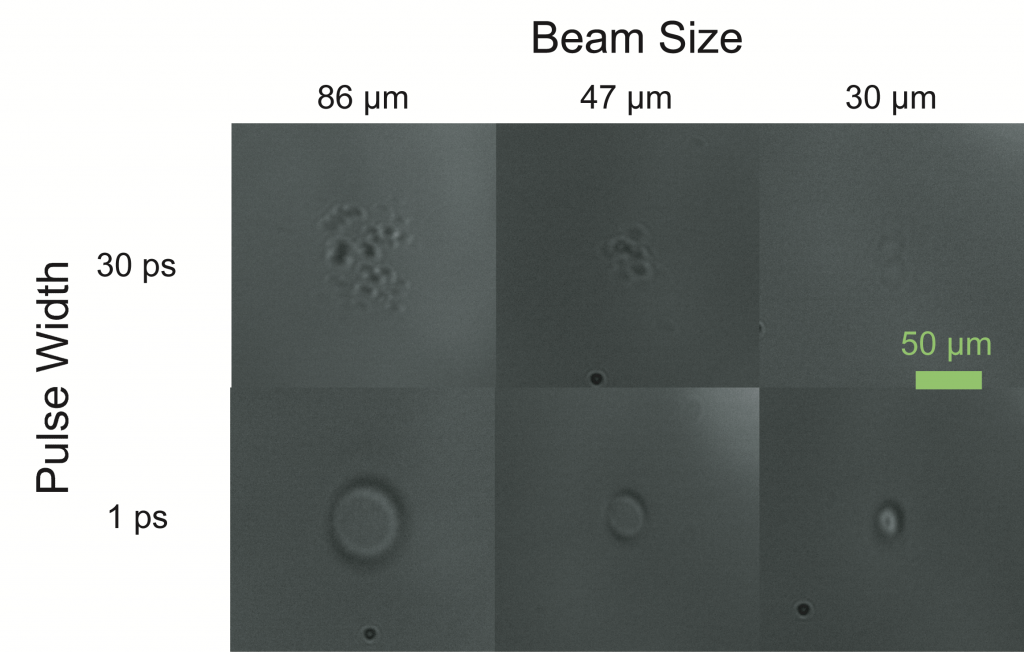Ted Laurence (14-ERD-014)
Abstract
High-peak-power laser pulses, when focused to relativistic intensities, can drive intense secondary sources such as energetic electron beams, proton beams, and kiloelectronvolt to megaelectronvolt x-ray sources that are highly relevant for important DOE and defense missions such as time-resolved backlighting of dense materials or future, laser-driven compact accelerators and their broad range of applications. Laser-induced damage of optical materials is a particularly interesting example of laser and material interaction in which the material itself is destroyed. We plan to investigate the key mechanisms of picosecond laser-induced modification in materials used for reflective and diffractive optics and for nonlinear materials and lenses, and understand the limits of these materials as a function of laser parameters and processing and environmental conditions. We are developing techniques to measure the key material parameters believed to be important in this regime, including multiple-photon absorption, free-carrier absorption, and avalanche breakdown in both intrinsic and defective materials, and we will use these measurements to develop models of optical lifetime. Finally, based on these results, we will develop processes or materials that improve the lifetime and performance of optics for short-pulse systems.
We expect to determine intrinsic fundamental damage thresholds and extrinsic surface-defect effects for dielectric materials used for coating short-pulse optical surfaces. In addition, we will characterize chemical and defect modification processes in short-pulse laser material caused by high-average-power conditions with short pulses. We expect to perform measurements of elementary excitation processes and the channels by which energy stored in the electronic system is transferred to the material in the solid state, and simulate material response in this intensity range. Identification of dominant failure mechanisms will improve the reliability of optics for picosecond-class systems using material and process solutions. We intend to explore conditioning by slowly ramping laser intensities as a mitigation strategy.
Mission Relevance
Optics for advanced high-energy laser systems are required to withstand high peak power at pulse lengths from under 1 to 100 ps—some under high-repetition-rate, high-average-power conditions. By establishing test parameters and clarifying fundamental mechanisms, we will help guide the design and operation of optics under these extreme conditions. This work is in support of the Laboratory's core competency in lasers and optical science and technology that contributes to the design of future high-energy and high-peak-power laser systems, and inertial fusion science and technology.
FY15 Accomplishments and Results
In FY15 we (1) completed work on fused silica surfaces for single-pulse damage tests from 500 fs to 30 ps; (2) developed large-beam-damage test facilities for 80 ps to 10 ns at 1,053 nm; (3) developed modeling for damage threshold measurements as a function of pulse output power and pulse width (500 fs to 30 ps), exploring effects of multiple-photon ionization and impact ionization; (4) began studies of multiple-pulse effects on silica and silica layers; (5) began damage tests on multiple-layer dielectric coatings; (6) developed transmission and reflection imaging at 1,053 nm, and photothermal measurements at visible and near-infrared wavelengths; and (7) continued developing pump–probe measurements.
The morphology of laser-induced damage depends on the mechanisms of damage. For single shots with 1-ps pulse widths, ablation pits scale with beam size (bottom row). For 30-ps pulse widths, localized defects at the surface dominate laser-induced damage (top row). Studying laser-induced damage in the picosecond regime spans the transition from fundamental, defect-free laser-induced damage to defect-driven laser-induced damage.
Publications and Presentations
- Alessi, D. A., et al., “Picosecond laser damage performance assessment of multilayer dielectric gratings in vacuum.” Optic. Express. 23(12), 15532 (2015). LLNL-JRNL-667566.
- Ly, S., et al., “Gigashot optical degradation in silica optics at 351 nm.” Optic. Exp. 23, 4074 (2015). LLNL-JRNL-664657.






